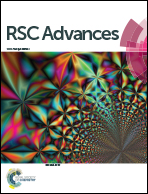Relation between temperature memory effect and multiple-shape memory behaviors based on polymer networks†
Abstract
The temperature memory effect (TME) refers to the capability of shape memory materials to memorize the deformation temperature (Td). In this article, the TME of multiple-shape memory polymer based on a PMMA/PEG semi-interpenetrating polymer network (PMMA/PEG semi-IPN) and a PMMA-PCL covalently crosslinked polymer co-network (PMMA-PCL CPN) are studied, and the relation between the TME and the multiple-shape memory effect (SME) is investigated. The results indicate that both the PMMA/PEG semi-IPN and PMMA-PCL CPN can show the TME in a specific range of response temperatures but not in its entire range of glass transition temperatures (Tg). This paper further confirms that broad transition temperature is the key to realizing the TME and the multiple-SME. Furthermore, we discover that the characteristic temperature of the TME corresponds to the multi-step transition temperature of the multiple-SME for the first time. Consequently, the characteristic temperature of the TME can be directly used as a multi-gradient Td to achieve the multiple-SME. Thus it facilitates the selection of a multi-gradient Td in the multiple-SME. The paper also reveals the internal relation of broad Tg, TME and multiple-SME of PMMA/PEG semi-IPN and PMMA-PCL CPN.


 Please wait while we load your content...
Please wait while we load your content...